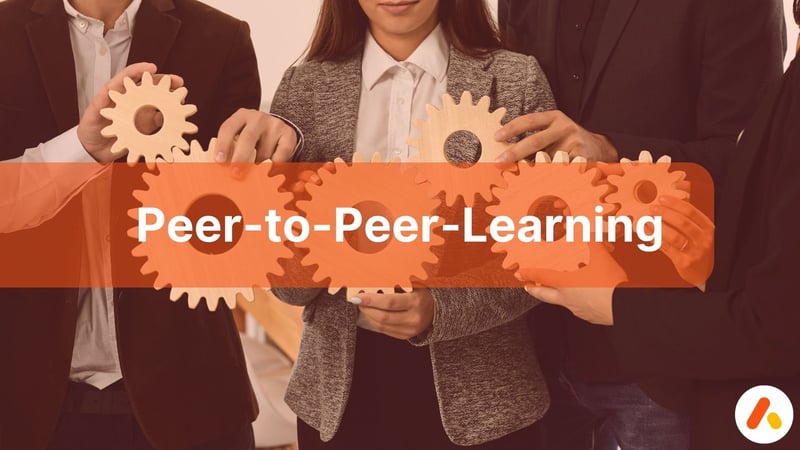
Advantage 1: Effective knowledge transfer with peer-to-peer learning
In a company, there are numerous ways to impart knowledge and improve employees' skills. One particularly effective method is peer-to-peer learning. Peer-to-peer learning gives employees the opportunity to learn from each other and share their knowledge and skills. This direct exchange between peers enables effective knowledge transfer, as learners can benefit from the experience and expertise of their colleagues. Unlike formal training or courses, peer-to-peer learning provides an informal learning environment where new ideas can emerge and resources can be created.
The learning process in peer-to-peer learning is dynamic and interactive. Employees can actively participate in their own learning process and take their individual learning needs into account. They have the opportunity to ask questions, discuss problems and find solutions together. This active participation not only makes learning more effective, but also more sustainable.
Another advantage of peer-to-peer learning is that it promotes collaboration and team spirit within the company. By employees sharing their knowledge and helping others to develop it, a sense of community and cohesion is created. This not only creates a positive working atmosphere, but also promotes the exchange of ideas and innovation.
In addition, peer-to-peer learning enables individual adaptation to the needs of the learners. Every employee has different strengths, weaknesses and interests. With peer-to-peer learning, learners can develop at their own pace and tailor their knowledge to their specific tasks within the company. This makes learning more personal and targeted. To successfully implement peer-to-peer learning in your company, it is important to promote an open learning culture and encourage exchange between employees. A Learning Experience Platform (LXP) can help facilitate peer-to-peer learning by providing a platform for knowledge sharing and collaboration. Through features such as the group and messaging function in U2D Aprenia, employees can easily exchange ideas and share knowledge articles.
Advantage 2: Promoting collaboration and team spirit through peer-to-peer learning
A successful company is characterized not only by the individual skills of its employees, but also by the harmonious interaction within the team. This is where the second advantage of peer-to-peer learning comes into play: the promotion of cooperation and team spirit.
Sharing knowledge and experience among employees creates a positive learning culture in which everyone contributes to moving the entire team forward. Peer-to-peer learning not only teaches new skills, but also strengthens the ability to work together effectively. By sharing their knowledge and helping others, employees grow together as a team. This creates a sense of connection and solidarity, which has a positive effect on the working atmosphere.
Peer-to-peer learning also promotes interdisciplinary exchange within the company. Through collaborative learning, different specialist areas can benefit from each other and gain new perspectives. This results in creative solutions and innovative ideas that can contribute to sustainable corporate success.
Another aspect is the strengthening of trust within the team through peer-to-peer learning. When employees share their own experiences and help others, they create an atmosphere of mutual respect and support each other in their personal development.
Advantage 3: Individual learning needs are taken into account
Peer-to-peer learning plays a decisive role in the field of knowledge management. A major advantage of this learning method is that it takes individual learning needs into account in the best possible way. All employees have different strengths and weaknesses as well as specific knowledge gaps that need to be filled.
With peer-to-peer learning, learners can decide for themselves which topics they want to explore in greater depth and which colleagues they want to learn from. This enables a tailored learning process that responds to the needs of individual employees. They can work on their personal challenges and improve their skills in a targeted manner. By exchanging ideas with other peers and benefiting from their expertise, they not only expand their knowledge, but also their practical skills.
Another advantage of peer-to-peer learning is the flexibility in the choice of learning methods. All employees have different preferences and learn best in their own way. With peer-to-peer learning, learners can decide for themselves whether they prefer to participate in training sessions, use online resources or interact directly with their colleagues.
Tips for implementing peer-to-peer learning in your company
There are a few important tips to consider when implementing peer-to-peer learning in your company. First, make sure your employees are aware of the benefits and possibilities of this learning approach. Give them the opportunity to learn more about it and ask questions. It is important that everyone involved understands the concept of peer-to-peer learning and recognizes the added value.
Another tip is to create a supportive learning culture in your company. Encourage openness and collaboration between employees so they can help each other build new skills and knowledge. Encourage your employees to share their knowledge and be available as a resource for their colleagues. It can also be helpful to offer specialized training or workshops to improve your employees' learning skills. Through targeted training, they can learn how to act effectively as peers and how to support others in their learning process.
Another recommendation is to use a Learning Experience Platform (LXP) to support peer-to-peer learning in your organization. An LXP provides a central platform for accessing resources, training and interactive learning elements. This facilitates the sharing of knowledge and promotes exchange between employees.
Last but not least, you should set up regular feedback rounds to review the progress of peer-to-peer learning and make adjustments. Take the opinions and suggestions of your employees seriously in order to continuously improve peer-to-peer learning.

How a Learning Experience Platform (LXP) supports peer-to-peer learning in the company
A Learning Experience Platform (LXP) can be a valuable support for peer-to-peer learning in your company. By using an LXP, the possibilities of peer-to-peer learning are expanded and optimized. An LXP enables employees to create their own learning resources and share them with other peers.
This creates a dynamic exchange of knowledge and skills within the team. With the help of an LXP, employees can access a variety of training, courses and resources to continuously expand their skills and knowledge. The platform offers personalized learning content that meets the individual needs of learners. This individualized approach makes peer-to-peer learning more effective.
An LXP also promotes collaboration and team spirit within the company. Employees have the opportunity to support each other in solving problems or developing new ideas. Learning together not only strengthens mutual trust, but also creates a positive working atmosphere.
The use of a learning experience platform also reduces training times and saves costs. As employees can access resources independently, there is no need for external training or expensive training programs. This enables the company to make optimum use of its internal resources and react flexibly to new requirements. Overall, an LXP offers an effective way of supporting peer-to-peer learning in the company and fully exploiting the benefits of this learning method.
Conclusion: More knowledge, more success - Benefit from the advantages of peer-to-peer learning in knowledge management
You have now gained a comprehensive insight into the benefits of peer-to-peer learning in knowledge management. Through this innovative learning method, you can not only expand your own skills and knowledge, but also actively contribute to the success of your company. The effective transfer of knowledge through direct exchange with colleagues makes it possible to learn new skills and deepen existing knowledge. At the same time, peer-to-peer learning promotes collaboration and team spirit within your organization. Individual learning needs are taken into account and all employees can set their own learning pace.
By using peer-to-peer learning, you create a valuable resource for your company: Your employees become learners and teachers at the same time. Training can be organized internally, saving costs and strengthening internal know-how at the same time. This learning process helps your company to become more agile and adapt quickly to changes.
To successfully implement peer-to-peer learning in your company, it is advisable to follow a few tips: Create an open learning culture where knowledge sharing is encouraged. Use modern technologies such as Learning Experience Platforms (LXP) to support peer-to-peer learning and facilitate access to relevant knowledge. Overall, peer-to-peer learning in knowledge management offers numerous benefits for companies of all sizes. It enables you to realize the full potential of your employees and ensure continuous development.


